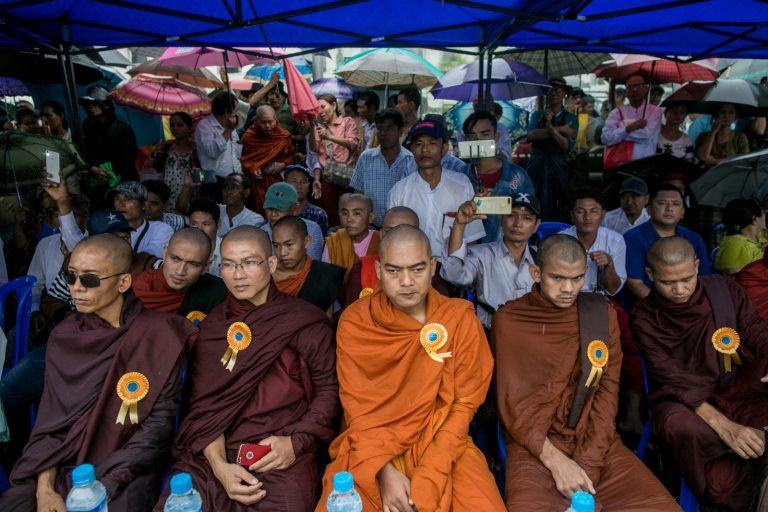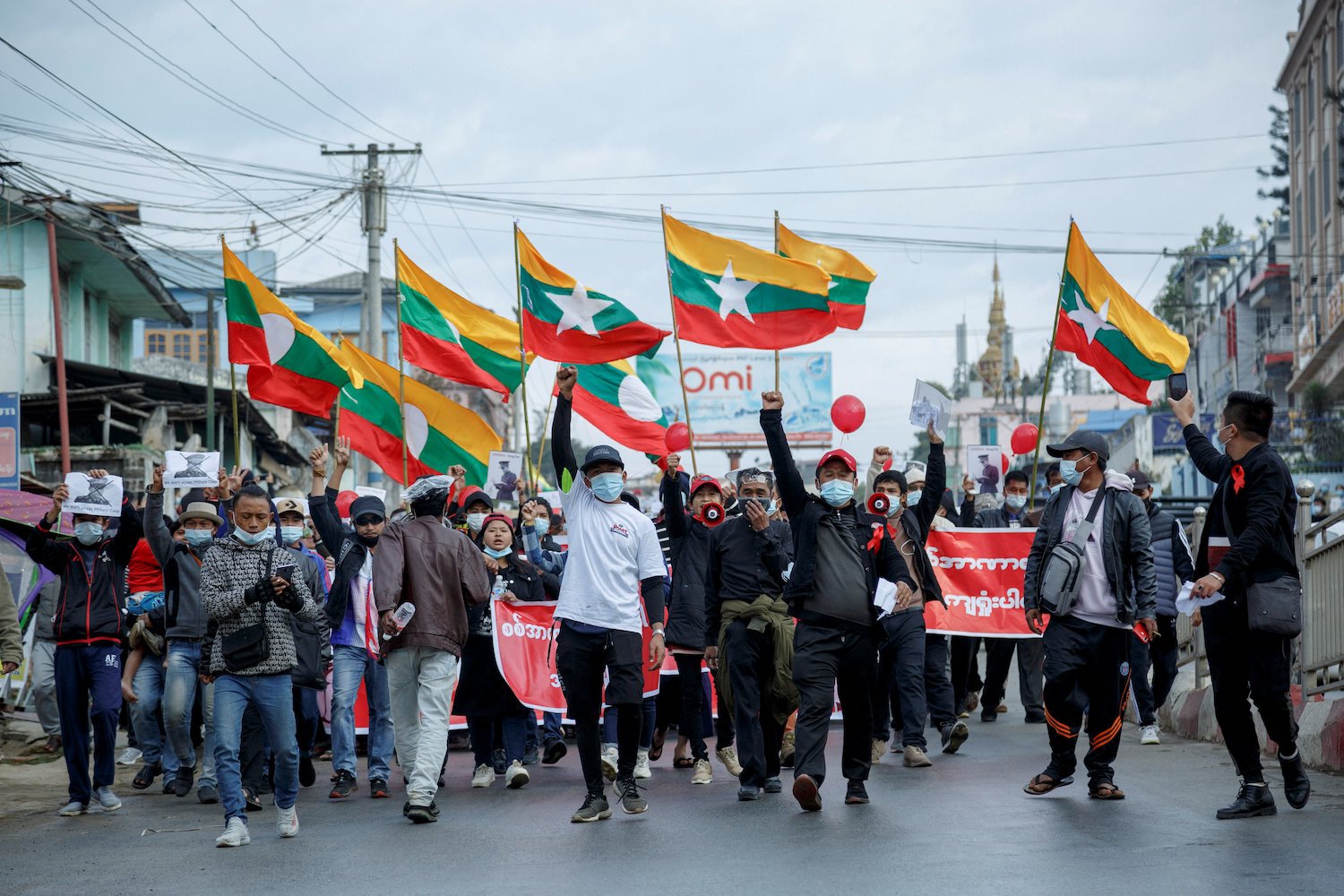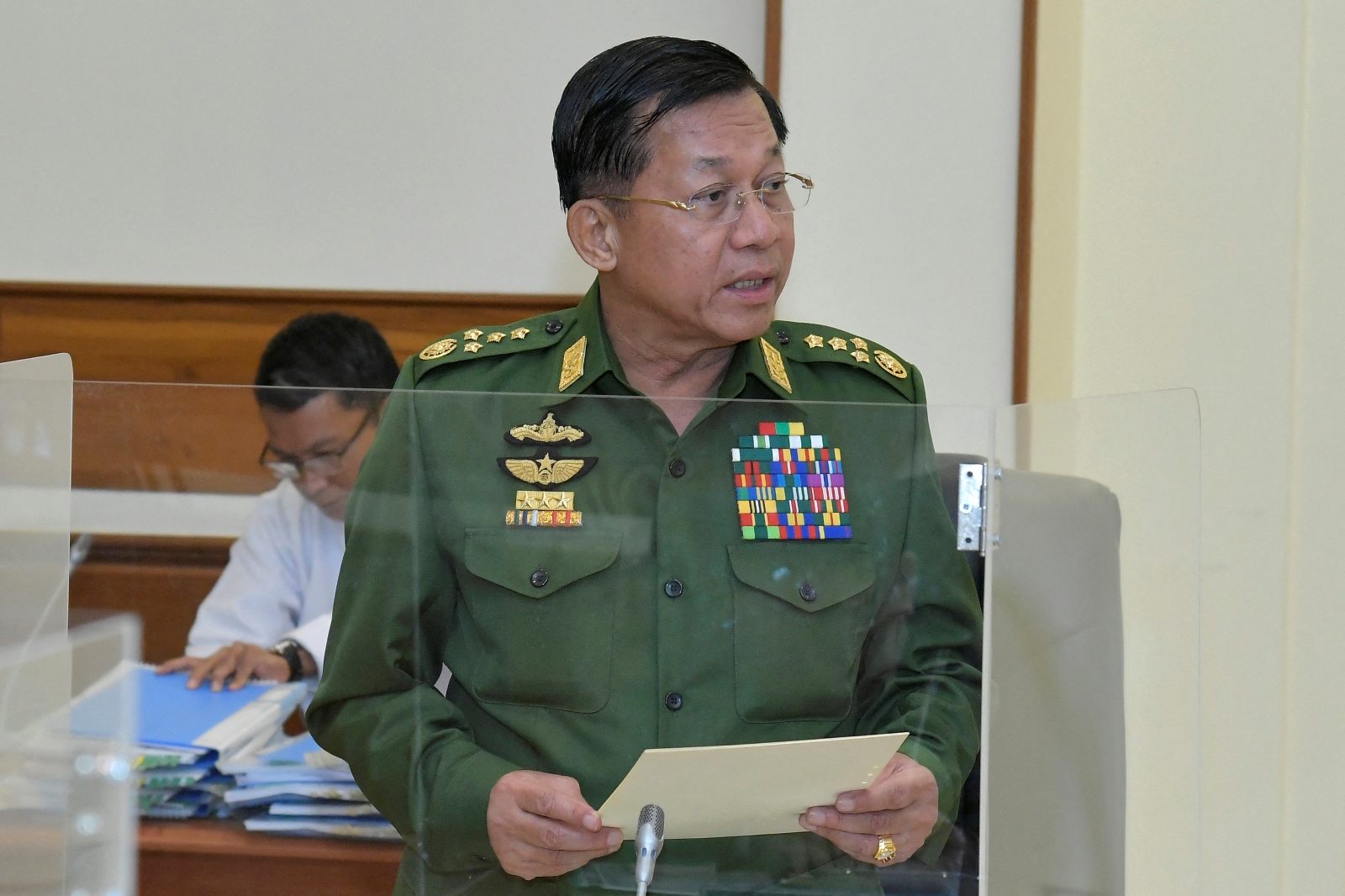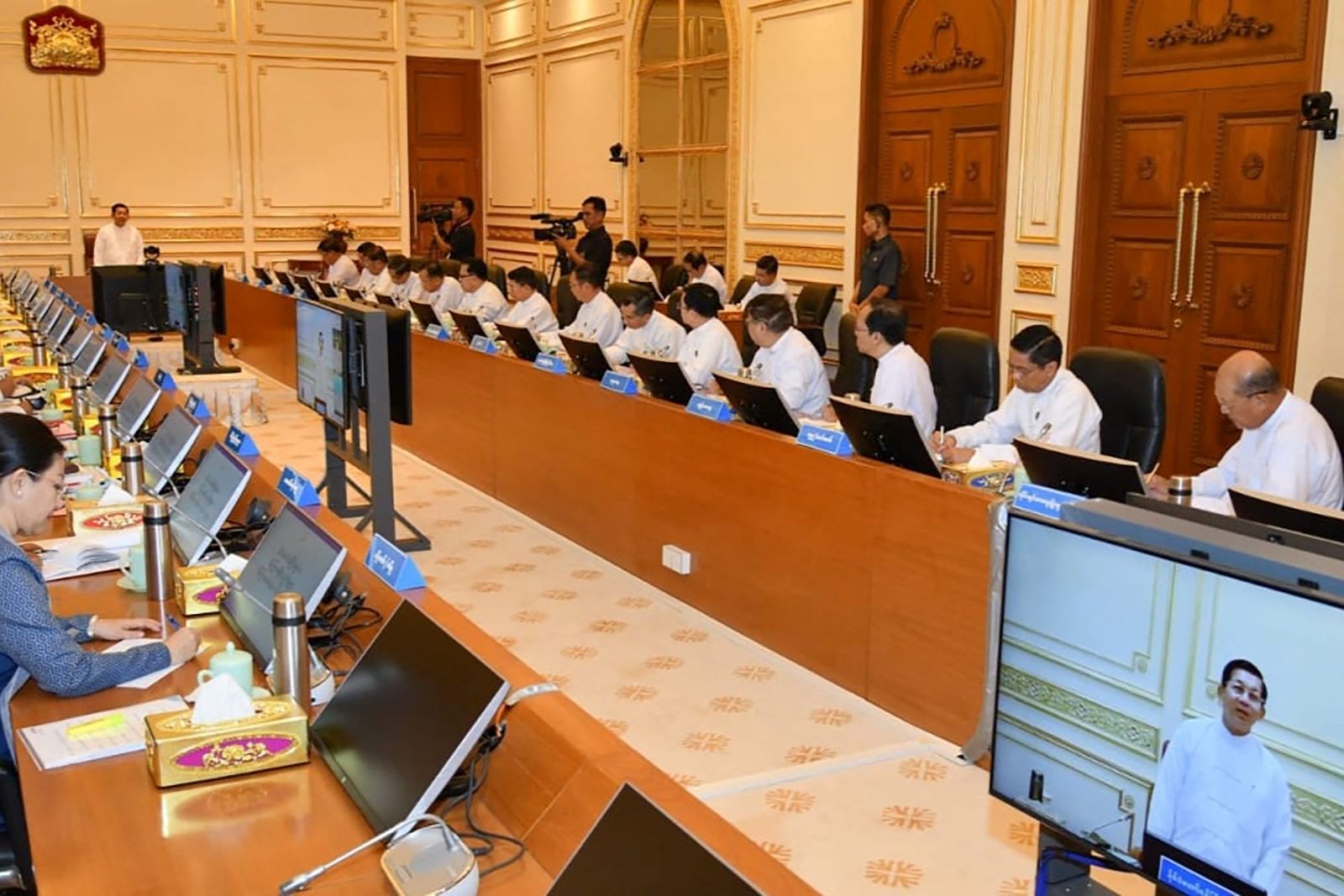The junta’s use of Buddhist nationalism has prevented many members of the sangha from joining the uprising against military rule, but it has also tarnished the reputation of Myanmar’s religious institutions in the eyes of the general public.
By FRONTIER
Just a few months before the 2020 election, Buddhist abbot U Gawthita Thara was sweeping dead leaves in his monastery compound in Hmawbi Township when a group of men entered with a large duffel bag.
“There were six people, and I was sure some of them were from the military,” he said, due to their appearance and demeanour. “But they just said they were from a nationalist group. They brought K1 billion with them, and asked me to be their monk. They also offered me a new car if I cooperated with them.”
When he realised the objective of the uninvited guests, he told them to leave and never return.
Gawthita Thara came to prominence during the Saffron Revolution, a series of monk-led protests against military rule in 2007. He was arrested that year and sentenced to 40 years in prison, but released after three.
“I told them I’m not a nationalist monk, I will always be a saffron monk. They left, but it was obvious that they were unhappy with my attitude,” he said.
Although he had ordered them not to return, another group came a few days after the military seized power on February 1, 2021. This time, the intruders were all uniformed soldiers, and they didn’t look like they were there to negotiate.
“It was night-time and my dogs barked loudly. I saw soldiers in front of my compound. I fled quickly and hid.”
Like many other prominent figures during those initial weeks after the coup, Gawthita emerged from hiding nearly every day to lead protests. But in March, his close sangha associate U Sandar Thiri was arrested by the junta. He knew the location of Gawthita’s safehouse, so the abbot made the decision to leave Yangon for Saw Township in Magway Region.
Soon after he arrived, the first armed clashes began in Magway and Sagaing regions, where farmers with homemade hunting rifles began fighting the military regime. This has spiraled into a broadening civil war, with post-coup armed groups known as People’s Defence Forces fighting alongside more established ethnic armed groups against the junta.
Gawthita Thara was trapped in the Sagaing-Magway conflict zone for nearly two years, travelling from monastery to monastery to avoid the clashes, before making his way to Thailand.
According to Gawthita Thara, he’s not the only monk who was approached by the military with offers of gifts before the coup, and some sought his advice about what to do.
“I told them to decide by their own common sense,” he said. But the military’s appeals were persuasive. “Most monks are poor, so many of them were influenced by the junta and became nationalist monks due to the military’s temptations.”
Compared to the Saffron Revolution, the current uprising, known as the Spring Revolution, has seen little participation from members of the sangha.
“The absence of monks in the Spring Revolution shows the success of the military’s strategy,” Gawthita Thara said.
Subverting the sangha
After successfully preventing most monks from participating in the protest movement, the junta has sought to portray itself as the guardian and protector of Buddhism, as successive military regimes have done in the past.
Stated-owned newspapers and television channels report daily about Senior General Min Aung Hlaing and his inner circle making donations to monks, or building monasteries and images of the Buddha.
During the funeral of famous monk Ashin Kumara Bhivamsa, aka Bhamo Sayadaw, Min Aung Hlaing and other senior leaders assumed a prominent role, carrying his coffin on their shoulders, despite a contentious relationship with the military in his lifetime.
Bhamo Sayadaw was chairman of the State Sangha Maha Nayaka Committee, also known as Ma Ha Na, and pursued some liberal reforms under the National League for Democracy government, like outlawing the anti-Muslim Ma Ba Tha group.
Ma Ha Na initially resisted the coup, reportedly calling for an end to the military’s violence against peaceful protesters and threatening to halt its activities in March 2021. But since then it has reverted to being subservient to the junta, as it was under previous military dictatorships.
“It was founded by dictator Ne Win,” said the former monk U Gambira, another Saffron Revolution leader, referring to the country’s first military ruler, who seized power in 1962 and founded Ma Ha Na in 1980. “They always dance for the rulers,” Gambira said from exile in Australia.
During the Saffron Revolution, as thousands of monks took to the streets, Ma Ha Na issued a directive banning monks from participating in “secular affairs”.

Now, with Ma Ha Na firmly under his control, Min Aung Hlaing has also spearheaded a project to build the world’s largest sitting Buddha statue in the military-dominated capital of Nay Pyi Taw, which Gambira condemned as a “statue made with blood”.
“They are killing people, setting fire to villages, dropping bombs, torturing political prisoners, and it’s getting worse and worse with no end. No matter how many pagodas they build, what they are doing is very cruel. So the god they build will only be a pile of bricks,” he said.
In June, Min Aung Hlaing met with Myanmar’s top businessmen and collected donations. The junta claimed that 101 businessmen donated more than K16 billion during the ceremony.
Frontier has found that similar fundraising events are also happening on a more localised level, and the so-called donations are not always made voluntarily.
Also in June, U Naing Win, a hostel owner in West Hlaing Tharyar Township, was summoned by his ward administrator along with every other hostel owner in the area. They were ordered to help raise funds for a new meditation building at the local pagoda, run by a pro-military monk.
“The administrator told us to collect donations from all the people who live in our hostels. The people had to give money even if they didn’t want to,” he said.
Hlaing Tharyar is mostly inhabited by low-income factory workers who live in dorm rooms in cheap hostels.
The Tatmadaw’s twisted Buddhism
Many also whisper that Myanmar military leaders combine traditional Buddhist practices with occult practices known as yadaya.
Former Captain Htet Myat, who defected from the military in June 2021, said military leaders have a guilty conscience and believe they can use religion as a tool to protect themselves from harm or karmic retribution.
“When the troops go to the front line, the commanders order the families who are left behind to chant the sacred scriptures together every night. Religion should be something you do voluntarily, but it doesn’t work that way in the military,” he told Frontier.
He said most military officers believe in fortune-telling, yadaya and yatra, a Burmese term for consulting astrologers to avoid misfortune.
“A battalion commander I know used to go to the monks and ask for amulets before going to the frontlines. Sometimes, his wife back home would do some yatra, like carrying a certain type of leaf to avoid danger. The commander ordered us to search for the leaf that his wife wanted. Out there it’s rare and difficult to find, and we had to search on the frontlines among the landmines,” he said.
Gawthita said yatra and fortune-telling have no basis in Buddhism.
“It’s a tradition that has widely spread among believers who use religion for their own interests,” he said. “It’s just pretending as usual for the dictators.”
But while the military’s adherence to Buddhism may be hypocritical, inconsistent with its actions and in contradiction of what the Buddha taught, there is little doubt that many soldiers and generals truly believe they are defending the religion.

Backfiring on Buddhism
In southern Shan State in March, the military allegedly massacred more than 20 civilians sheltering at a monastery, as well as three monks. RFA reported in April last year that nearly 40 monks had been killed since the coup with another 40 jailed.
“They are not humans,” said Gawthita Thara. “They use the monasteries as their base in every village when they arrive.”
But how does a supposedly Buddhist institution justify these atrocities?
Htet Myat said soldiers don’t hesitate to attack monks, because they are brainwashed by the regime.
“If the commander wants the soldiers to destroy a monastery, they just tell them the monks in that monastery are fake monks who are living with women,” he said, adding that rank-and-file soldiers often genuinely believe these lies.
Currently serving soldiers remain defensive of the Tatmadaw and its relationship with Buddhism.
Captain Thet Paing* from Pyin Oo Lwin Township in Mandalay Region, said he was well-versed in Buddhism even before he entered the Defence Services Academy over a decade ago, but claims his faith has grown stronger since.
“I had to participate in many religious events held by my school and then my battalion. So, I have stayed very close to Buddhism and the monks. Even when I attended my master’s programme in Russia, there were monthly events at the Myanmar monastery in Moscow,” he told Frontier, saying his religious experience has been “very peaceful and rewarding”.
But Thet Paing doesn’t feel the same way about all religions.
“It’s really hard for me to sit together with Muslims. They kill animals, right? I think they also wouldn’t like us Buddhists. I don’t hate them, but I just don’t like them,” he said.
He refused to accept that the military has killed monks or damaged pagodas, instead blaming the PDFs, but also seemed to justify the military attacks by claiming the victims support “the rebels”.
“The monks should stay away from armed conflicts and shouldn’t support the rebels while the military is doing its duty,” he said.
Sayadaw U Ottara, the former chair of Ma Ba Tha in Meiktila Township in Mandalay
Region, where one of the worst massacres of Muslims occurred during communal violence in 2013, said he is grateful that leaders who protect Buddhism are ruling the country.
“It’s a really good opportunity to maintain our culture and our religion. We don’t want other religions to influence our country. This is a Buddhist country,” he told Frontier.
Others seemingly recognise that the incompetence of military rule may be backfiring on Buddhism in Myanmar, but have made efforts to defend the regime.
In a livestream in September last year, ultranationalist monk Ashin Agga Dhamma said because people are struggling economically, they have less time to focus on Buddhism. But he appealed to people not to blame the military, despite it presiding over a calamitous economic collapse.
Instead Agga Dhamma had harsh words for the resistance, saying that all of Myanmar’s conflicts since independence are the fault of ethnic armed groups, many of which are Christian.
“If there was only Buddhism, the world would be peaceful. The wars that are happening now in the world are because of other religions,” he said.
U Tun Kyi, a member of the Spring Revolution Interfaith Network, said that the actions of the regime and its pliant monks are sullying the reputation of Buddhism, and could make ordinary people turn away from the faith.
“The cooperation between the authorities and the monks has greatly affected the image of our country. The image of Buddhism has become extremely ugly,” he said.
The hostel owner in West Hlaing Tharyar showed glimmers of this when he vented his frustration over the forced donations.
“It’s not donating, the monks are robbing money from people,” he said. “The people are working hard to make ends meet in their daily lives, and already have enough struggles.”
Some are even worried the military’s actions – purportedly taken to protect Buddhism – could push an entire generation to abandon the religion.
“If the activities of the junta and its allied monks continue like this, Buddhism will soon disappear from our country,” said 60-year-old lifelong devoted Buddhist U Naing Win.
But Gambira remains optimistic, believing the current conflict has laid bare the corruption and hypocrisy of the nationalist pro-military monks, which will help Myanmar rebuild in the future.
“They can’t influence the people anymore,” he said. “Now the public knows their true colours.”
He said if the revolution succeeds, Myanmar will achieve a purer form of Buddhism.
“When it comes time to reconstruct Buddhism, after removing Min Aung Hlaing and his group, I believe the public will participate enthusiastically.”
* indicates use of pseudonym for security reasons







